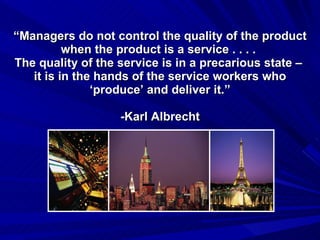1 The Service Industry
- 1. “ Managers do not control the quality of the product when the product is a service . . . . The quality of the service is in a precarious state – it is in the hands of the service workers who ‘produce’ and deliver it.” -Karl Albrecht
- 2. Customer Care Week One The Service Industry and Challenges
- 3. Objectives Look at the components of the service economy. Discuss the contribution of global tourism and hospitality. Define services and the service process Review the contemporary challenges for service organisations Review the characteristics of service operation
- 4. Learning Criteria Identify the reasons for using customer service policies
- 5. Components of Travel and Tourism Industry O.H. 1.1
- 6. Travel Patterns Have Changed
- 10. The “Other Hospitality Operations” Segment
- 11. The Tourism, Hospitality and Leisure – in Europe 440m Visitor Arrivals to European States in 2005 10% of Europe’s Direct and Indirect GDP 20 million jobs, mainly in SMEs
- 12. Ã˝
- 13. Ã˝
- 14. Over 2 million jobs are sustained by tourism activity in the UK, either directly or indirectly There are an estimatedÃ˝ 1.45 million jobs directly related to tourism activityÃ˝in the UK, someÃ˝ 5% of all people in employment in the UK ApproximatelyÃ˝ 132,400 of these jobs are inÃ˝ self-employment Ã˝ Source: Office for National Statistics and DCMS (2007) Tourism, Hospitality and Leisure - UK
- 15. Inbound Tourism to the UK in 2007 The 32.6 million overseas visitors who came in 2007 spent £16.0 billion in the UK. In 2007 the UK ranked sixth in the international tourism earnings league behind the USA, Spain, France, Italy and China Visit Britain (2008)
- 16. The top five inbound markets for the UK in 2007 Country Visits (000) Country Spend (£m) USA 3,587 USA 2,554 Germany 3,385 Germany 1,217 France 3,323 Irish Rep 969 Irish Rep 2,975 France 865 Spain 2,158 Spain 848
- 17. Tourism, Hospitality and Leisure - UK Generates 4.0% of GDP Contributes £75 billion to the economy Created 1 in 5 of all new jobs in last 10 years Comprises of 300,000 establishments (with 85% employing fewer than 25 staff) (People 1 st 2008)
- 18. Ã˝
- 19. The UK service sector is going from strength to strength with business volumes growing at their fastest rate for a year. Profitability growth in the sector is also at a three-year high As a result, confidence among firms is now at a five-year high. But the study warns rising wage costs and skills shortages could hold back growth in the sector. "There is real evidence of an upturn in the service sector," (CBI, Edmonds S, Grant Thornton 2004) Tourism, Hospitality and Leisure - UK
- 20. Tourism, Hospitality and Leisure The Customer Challenge
- 21. Tourism, Hospitality and Leisure The Customer Challenge Rising customer expectations require continuous improvement in quality standards and innovation
- 22. Current Issues of Customer Service It is frequently difficult to measure the financial benefits of customer service. It may be challenging to convince some financial managers of the long-term payoffs. Customers have high expectations of what they hope to gain from the people with whom they do business, Frequently customer service providers do not know what those expectations are. Customers have grown accustomed to improved levels of customer service and expect considerable latitude in customer service, but the resulting cost is becoming prohibitive for many businesses.
- 23. Current Issues of Customer Service (Continued) Technology provides the opportunity for faster responses to customer questions. It also creates the requirement that customer service providers have additional training. Customer service is an opportunity that no professional can afford to ignore. Customer service is frequently the distinguishing difference between two or more companies that offer the same product or service.
- 24. New Trends in Customer Service Accessibility for the customer Immediacy of response Feedback from customer to customer service provider Outsourcing of all or part of customer service functions Nontraditional examples of customer service
- 25. Challenges! Challenges! Changing labour conditions Escalating business costs Rising energy costs Increased renovation and construction costs Effects of and scares about natural disasters / ecology
- 26. More Challenges! On-going concerns about safety and security Increased consumer expectations Accelerated change and merging of technologies Increasing consolidation of brands and companies
- 27. Four main types of service process
- 28. Capability versus commodity processes
- 29. Defining services “ Activities, benefits and satisfactions, which are offered for sale or are provided in connection with the sale of goods” (American Marketing Association)
- 30. Defining services “ Services include all economic activities whose output is not a physical product or construction, is generally consumed at the time it is produced, and provides added value in forms (such as convenience, amusement, timeliness, comfort or health) that are essentially intangible concerns of its first purchaser” (Quinn at al, 1987)
- 31. The Service Process Process The actual procedure, mechanisms and flow of activities through which a service is delivered (Zeithaml and Bitner,1986)
- 32. The Service Process The dimensions of a process’s efficiency and effectiveness: Length : the number of steps that participants have to follow in order to effect service delivery Duration : the time that elapses from the first to the last activity of the service delivery process Logistical effectiveness : the degree of smoothness in the flow of the steps of the service delivery process
- 34. Service = experience + outcome
- 35. Figure 1.3 Managing service and service operations
- 36. Inside-out versus outside-in Adapted from work by John Hughes, the Customer Service Network, UK.
- 37. Seminar Best Experience Worst Experience Any similarities between experiences
- 38. Next week Ritz Carlton – 12 steps Marriot Four Seasons Intercontinental Prepare for presentation to class for next week





































